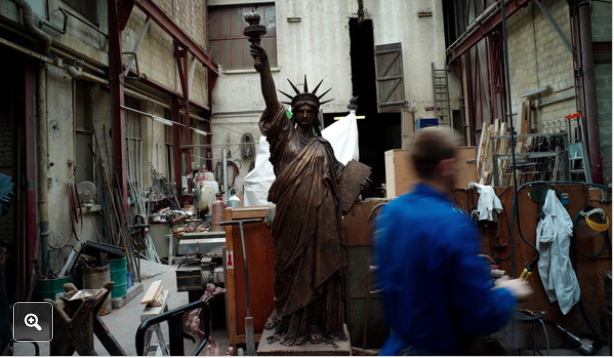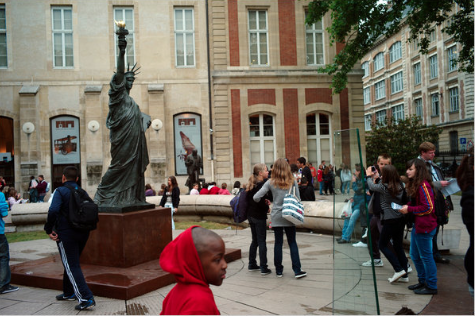
The New York Times
Lady Liberty
For the last century or so, people wanting their own Statue of Liberty settled for a knockoff, like the version that looks down from a hotel rooftop in Pristina, Kosovo, or the copy in the bar of a bowling alley in Warrington, England. Now those with a preference for authenticity (and the means to indulge it) can buy the closest thing possible — a bronze cast made from the plaster sculpture that Frédéric-Auguste Bartholdi used to create the famous monument.
The seller is a French art dealer, Guillaume Duhamel, who specializes in Picasso, Dubuffet and the like. Six years ago he was accompanying his son’s elementary school class on a visit to the Musée des Arts et Métiers, a museum of engineering inventions in Paris. He paused to admire Foucault’s pendulum and various old-fashioned flying machines, then stopped in his tracks.
“What is that thing?” he thought, staring up at a familiar stern-faced figure holding a torch and wearing a spiky crown.
The next day he called the museum and learned that the sculpture was the 1878 plaster model, 9.4 feet tall from the base to the torch, that Bartholdi enlarged 16 times to make the 151-foot-tall iron and copper statue in New York Harbor. Bartholdi’s widow bequeathed the model to the museum in 1907, three years after his death.
When Mr. Duhamel first spotted it, it was an “inédit,” meaning it had never been cast. “It seemed too unbelievable to be true,” he recalled. He offered the museum a deal; he would pay to cast 12 sculptures, the maximum number of casts permitted by French law. The museum would keep the first one, and he would be free to sell the others, to recoup his investment and, ideally, make a profit.
The proposal suited both parties. In the past the museum has refused numerous loan requests for the sculpture, notably from American institutions, since it was too fragile to travel. Now it could lend out its bronze. As for Mr. Duhamel, he would assume a financial risk, but in the hope of getting his asking price of $1.1 million apiece.
He agreed to require potential clients to sign a contract promising to respect the values the Statue of Liberty represents. “It’s not a moral inquisition, but you don’t want Al Qaeda buying one,” he explained.

Previously the museum had considered casting the sculpture on its own, but it wasn’t feasible. Because “we are a national institution,” said Pierre-Yves Gagnier, a museum director, “we don’t have the finances for a project of this size.”
Once the opportunity arose with Mr. Duhamel’s offer, the museum nearly nixed it, fearing that the plaster was too delicate to coat with silicone to make a mold. The project stalled for a year or two, until the fortuitous arrival on the scene of an innovative French company, 7Dworks, that was able to scan the sculpture and draw a digital model of it without touching it, accurate to within a hair’s thickness. A virtually identical reproduction could then be made for casting.
In a workshop south of Paris there are now four bronze Statues of Liberty in various states of completion. This is the Fonderie Susse, France’s oldest art foundry, which is casting the sculpture using the lost-wax method, a technique that dates back to antiquity. Lady Liberty looks slightly out of place there, face to face with a Max Ernst bronze originally made from farm equipment.
“She’s not that tall,” said Hubert Lacroix, the foundry’s owner. “But she has an extraordinary power. When she’s in the middle of the atelier she absorbs all the attention.”
He said each of the Liberty bronzes weighs around 1,000 pounds and requires 600 hours to create, though the initial one took a year.
Two of the bronzes have already found buyers in private collectors, one of whom has placed his in the living room of a home facing Lake Geneva in Switzerland.
The very first bronze to be cast took up residence two months ago in the courtyard of the Musée des Arts et Métiers, where on Thursday night the American Ambassador to France, Charles H. Rivkin, dedicated it. Before the event he said it would “highlight an iconic symbol of Franco-American friendship that has served as a beacon to millions of immigrants and generations of Americans.”
Standing watch at the museum entrance, the sculpture has proven an irresistible draw for visitors, many posing for pictures with one arm aloft. They are Italian tourists, boisterous schoolchildren, French couples — not exactly huddled masses, but still excited to see the lady with the torch.
Read on The New York Times